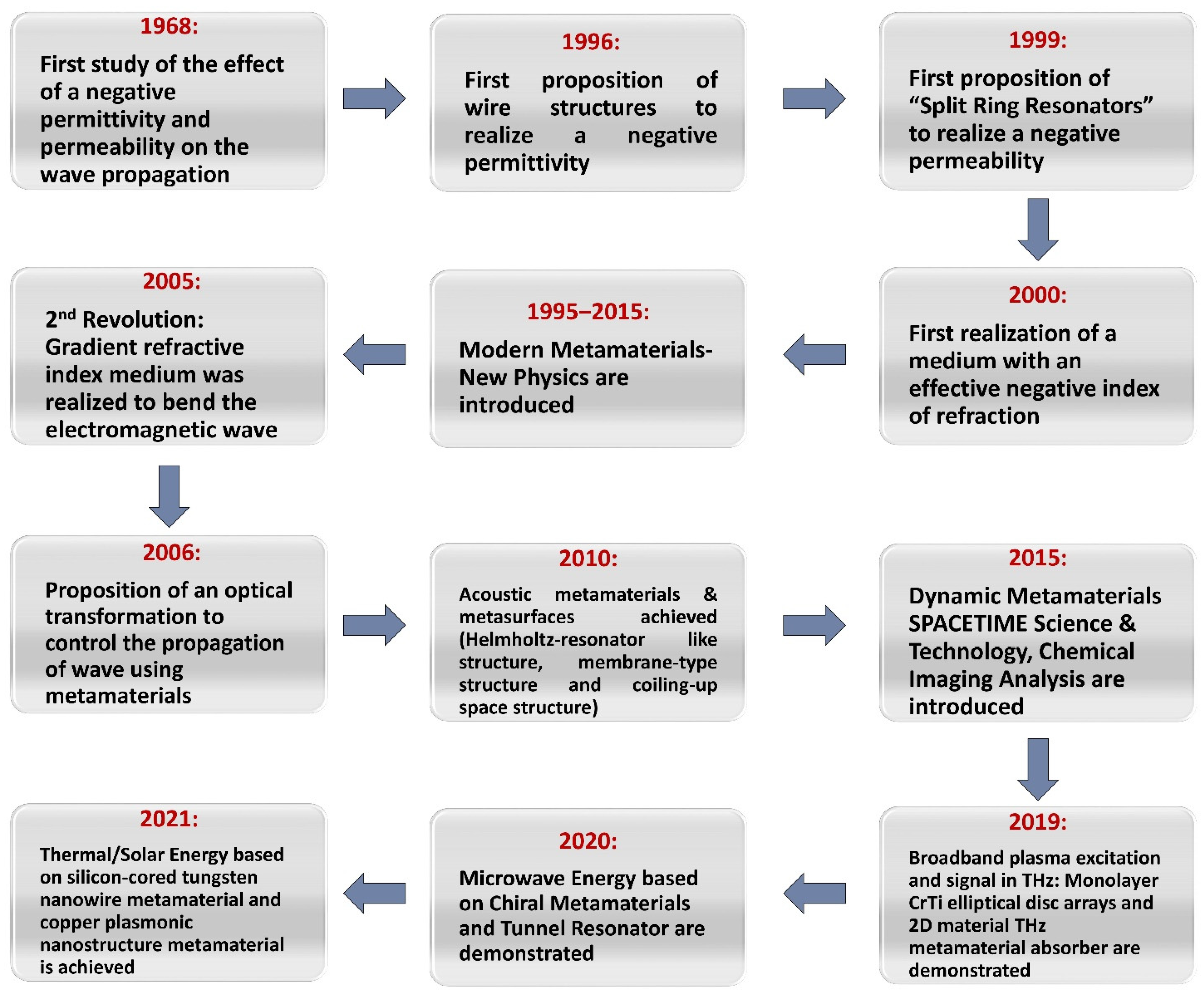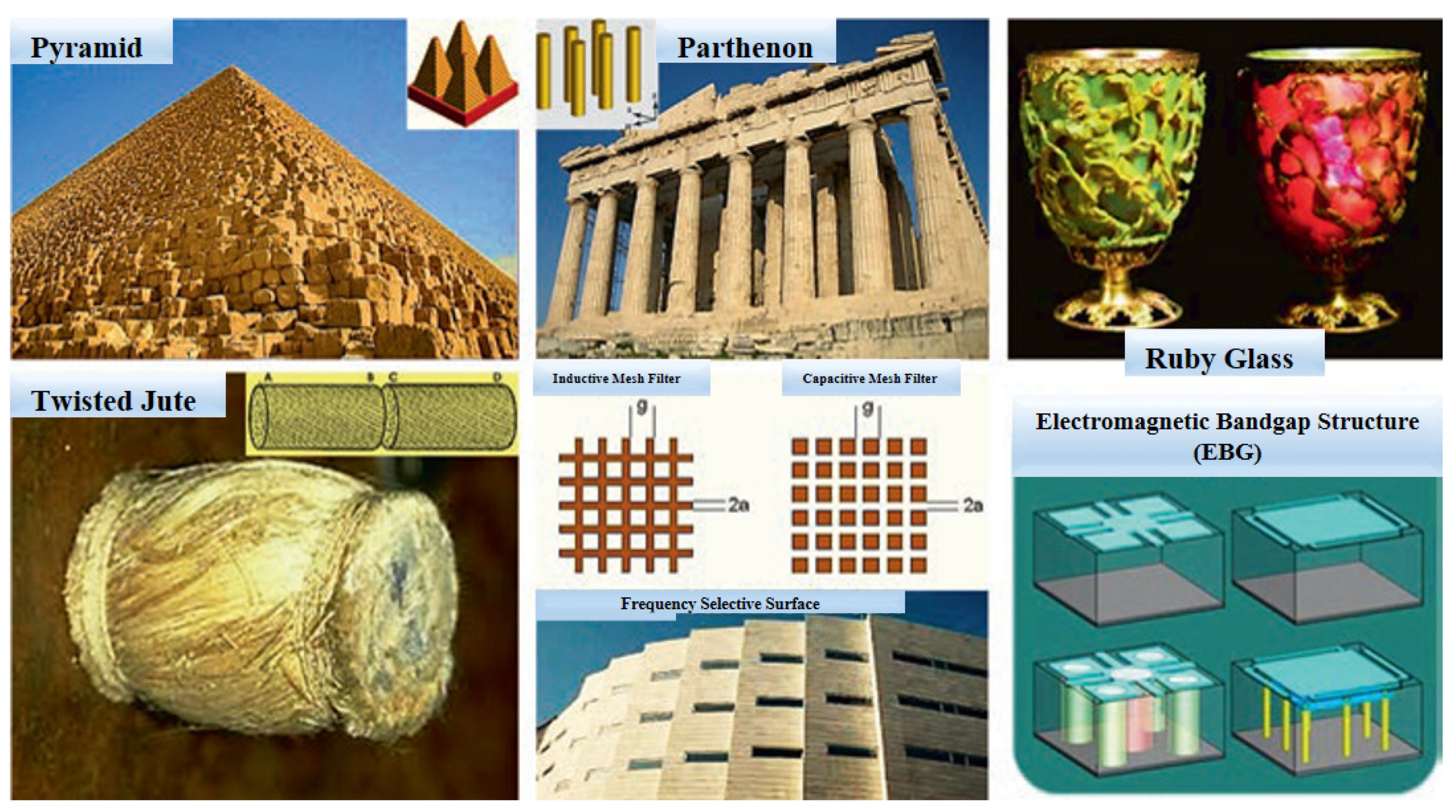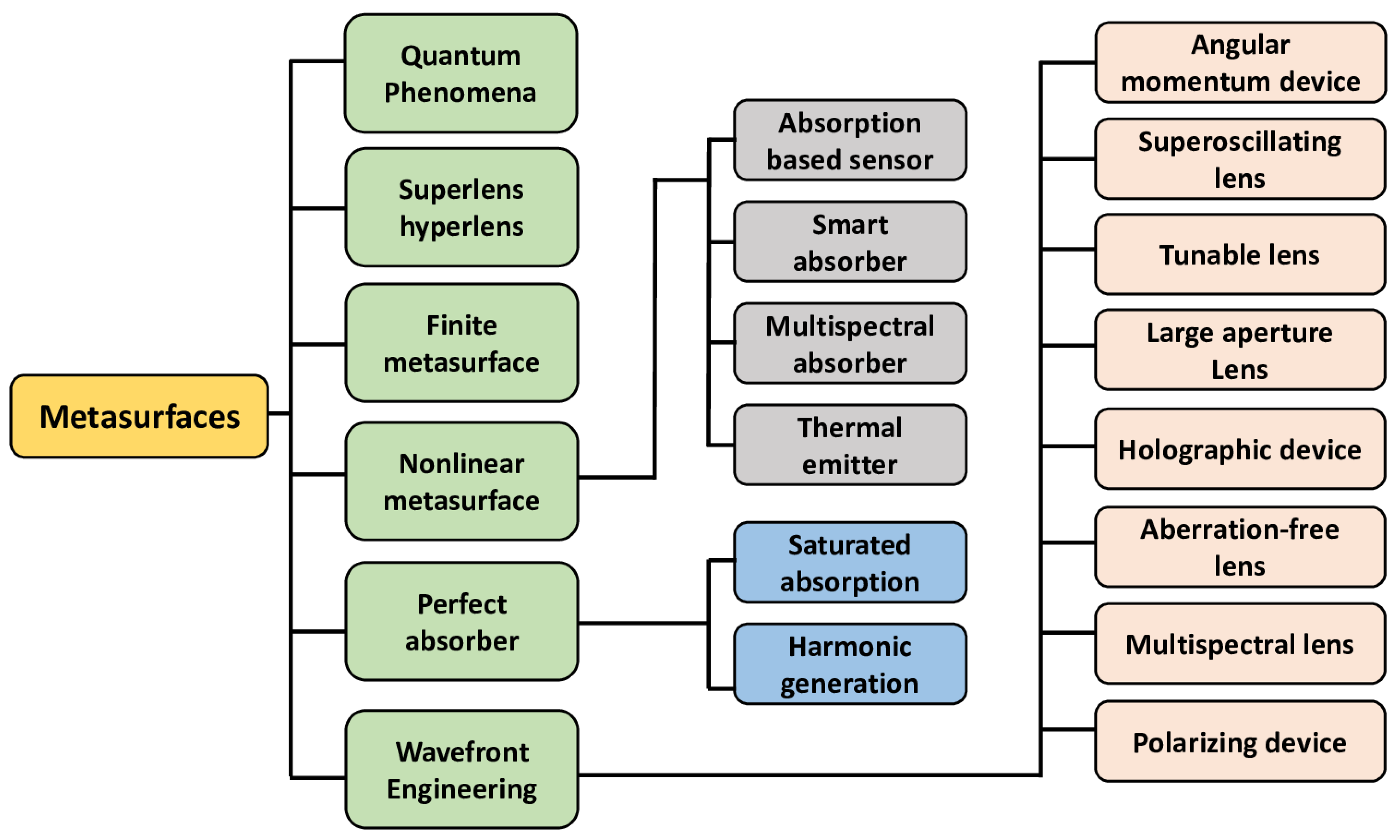You're using an outdated browser. Please upgrade to a modern browser for the best experience.

Submitted Successfully!
Thank you for your contribution! You can also upload a video entry or images related to this topic.
For video creation, please contact our Academic Video Service.
Video Upload Options
We provide professional Academic Video Service to translate complex research into visually appealing presentations. Would you like to try it?
Cite
If you have any further questions, please contact Encyclopedia Editorial Office.
Ali, A.; Aissa, B.; Mitra, A. Metamaterials. Encyclopedia. Available online: https://encyclopedia.pub/entry/21163 (accessed on 25 December 2025).
Ali A, Aissa B, Mitra A. Metamaterials. Encyclopedia. Available at: https://encyclopedia.pub/entry/21163. Accessed December 25, 2025.
Ali, Adnan, Brahim Aissa, Anirban Mitra. "Metamaterials" Encyclopedia, https://encyclopedia.pub/entry/21163 (accessed December 25, 2025).
Ali, A., Aissa, B., & Mitra, A. (2022, March 30). Metamaterials. In Encyclopedia. https://encyclopedia.pub/entry/21163
Ali, Adnan, et al. "Metamaterials." Encyclopedia. Web. 30 March, 2022.
Copy Citation
Metamaterials are amongst the advanced materials made up initially with metal structures. However, there is a huge ongoing work on dielectric metasurfaces and metamaterials with the aim of replacing metal structures with dielectric ones in order to reduce the electromagnetic losses.
metamaterial
metasurface
metadevice
plasmonic
nanoparticle
1. Introduction to Metamaterials
Metamaterials are amongst the advanced materials made up initially with metal structures. However, there is a huge ongoing work on dielectric metasurfaces and metamaterials with the aim of replacing metal structures with dielectric ones in order to reduce the electromagnetic losses.
Metamaterials’ physical properties rely mostly on their structures. In 1968, Veselago [1] explored materials of negative permittivity and permeability. Such characteristics though are not present in naturally found materials and can only be generated in metamaterials. During the electromagnetic wave transmission such as wave propagation, the effects generated by metamaterials can be clearly observed. Evolution of the topic of metamaterials with time is presented in Figure 1. From an applications point of view, metamaterials could be used in devices such as antennas [2], photonic filters [3], integrated network sensors [4] or new superlayers for the microwave and terahertz fields [5]. The deep understanding of metamaterials offers fullness of novel options ranging from laboratories concepts to practical engineering applications.
 Figure 1. Schematic depicting the evolution of the field of metamaterials over the years, from 1968 to nowadays.
Figure 1. Schematic depicting the evolution of the field of metamaterials over the years, from 1968 to nowadays.The term “metamaterial” comes from the Greek words “meta” and “material”, while “meta” refers to something that is beyond usual, rearranged, changed or innovative. It is an engineered material intended to attain unique properties and capabilities which are absent in natural materials. The term metamaterial is introduced by Walser in 1999 [6]. Metamaterial cannot be obtained from any continuous and homogenous medium, that is why the metamaterials are always of a composite nature. Usually, metamaterials are constructed from discrete resonant micro- and nanometer-scale objects which mimic the electromagnetic reaction of atoms and molecules of natural substances to make them interact with light and other forms of energy in specific controllable ways.
2. Evolution of Metamaterials
In 2019, Vicari et al. [7] modeled the growth of metamaterial-containing devices across eight different applications (displayed in Figure 2). The model looked at potential addressable markets based on various parameters including the cost, maturity and performance. It is based on inputs from a wide range of primary and secondary research. Vicari and his team explicitly seized the markets for metamaterial components in communications, sensing and acoustic applications. Many other applications are likely to appear and were grouped together into an “other” category. Market forecast for metamaterials is put at $10.7 billion by 2030. Through 2025, communications uses are by far the leading growth driver; however, by 2030, sensing uses grow to be the largest segment, reaching $5.5 billion compared to $4.4 billion in communications.
 Figure 2. Metamaterials market forecast: metamaterial devices are poised to grow to $10.7 billion by 2030 in 5G networks, autonomous vehicles and connected vehicles. Adapted from Ref. [7].
Figure 2. Metamaterials market forecast: metamaterial devices are poised to grow to $10.7 billion by 2030 in 5G networks, autonomous vehicles and connected vehicles. Adapted from Ref. [7].The origin of metamaterials could be linked to various examples of the pyramid brick wall, Parthenon columns and medieval ruby glass, as shown in Figure 3. Other “historical” examples of metamaterials are, for instance, the work on the rotation of the polarization plane through artificial twisted structures performed in 1898, and the artificial dielectric structures for microwave antenna lenses achieved in 1945. The modern (formally named) metamaterial was noticeable when Pendry et al. [8] anticipated that arrays of conducting wire can function with a negative value of effective permittivity at a relatively low frequency (<200 THz), whereas the split ring resonators (SRRs) can be utilized to facilitate a strong magnetic resonance which resulted in an effective permeability negative value. In 2000, by linking both structures and overlapping the negative frequency bands, a metamaterial carrying a negative refraction index was presented for the first time, where the directions of the wave vector and the energy flux, also known as backwards waves, were opposite in a negative index medium. These experiments have proven the predictions of Veselago’s 1968 negative index materials [1], such as negative refraction, Doppler’s reversed effect and Cherenkov’s reversed radiation [9].
 Figure 3. Examples of some “historical” original metamaterials, adapted from Ref. [10].
Figure 3. Examples of some “historical” original metamaterials, adapted from Ref. [10].Metasurfaces
Depending on the materials employed and geometry, and per their frequency responses, metasurface-based device’s classification has been made as narrowband [3][11], broadband [12][13][14] and wideband [15]. Fano resonance is the typical case of narrowband application. The sharp resonance peak complemented by strong local field enhancement is amongst the most important aspects of Fano resonance [16][17]. It is the foundation of several practical applications such as nonlinear photonics and biological sensing. Metasurface dispersion for multiband and broadband applications can support super-resolution imaging beyond the diffraction limit, high-performance color filter, broadband absorbers and polarizers [15][18][19][20].
Metasurfaces are two-dimensional (2D) or planar versions of metamaterials dealing with subwavelength thickness [21][22][23]. Metasurfaces have unique abilities to block, absorb, concentrate, disperse or guide waves on the surface at a grazing incidence angle and in space at normal and oblique incidence, from microwave to visible frequencies. Surface waves can be well controlled by designing impedance cells to manipulate phase or group velocity [24][25]. These are patterned in such a way that may guide or separate waves in certain directions, and/or used to control scattering. By controlling the metasurface, unit cell sizes and shapes, multiple effective surface refractive indices can be achieved and different functions can be patterned on the surface. They can be used to design 2D microwave/optical lenses for antenna systems and planar microwave sources, such as Luneburg and fish-eye lenses [26].
The perspective of current implementation and growing metasurface and metadevice developments are shown in Figure 4. Different metasurfaces demonstrate different capabilities. The surface impedance can be modified and controlled by the structure of the cells that are widely applied to surface wave absorbers and surface waveguides. These metasurfaces also enable transmission and reflection to shape the beam.
 Figure 5. Chart summarizing the metasurfaces’ and metadevices’ applications.
Figure 5. Chart summarizing the metasurfaces’ and metadevices’ applications.Three-dimensional (3D) metamaterials, made often with periodic artificial materials composed of metals and/or dielectrics, have been widely studied owing to their unique interaction with electromagnetic waves that exceed the capabilities of naturally occurring or homogeneous materials [11][27][28]. Their exceptional ability to manipulate waves is due to their strong interaction with electrical and/or magnetic fields, typically provided by unit cell geometry-controlled resonant effects. These capabilities result in a broad range of applications such as antenna efficiency enhancement [29][30], ideal absorbers [31][32][33], superlenses [8][34], cloaking [35][36][37], elimination of scattering [12][38] and energy harvesting [39][40][41], among other applications in microwave and optical frequencies. When active and nonlinear components such as transistors [42][43], diodes [43][44], and varactors [45][46][47] are added to metasurfaces, novel tunability and switching abilities become possible.
References
- Veselago, V.G. The electrodynamics of substances with simultaneously negative values of ε and μ. Sov. Phys. Uspekhi 1968, 10, 509–514.
- Boyarsky, M.; Sleasman, T.; Pulido-Mancera, L.; Fromenteze, T.; Pedross-Engel, A.; Watts, C.; Imani, M.; Reynolds, M.; Smith, D. Synthetic aperture radar with dynamic metasurface antennas: A conceptual development. J. Opt. Soc. Am. A Opt. Image Sci. Vis. 2017, 34, A22–A36.
- Hsu, H.-T.; Chang, T.-W.; Yang, T.-J.; Chu, B.-H.; Wu, C.-J. Analysis of Wave Properties in Photonic Crystal Narrowband Filters with Left-Handed Defect. J. Electromagn. Waves Appl. 2010, 24, 2285–2298.
- Lou, J.; Liang, J.; Yu, Y.; Ma, H.; Yang, R.; Fan, Y.; Wang, G.; Cai, T. Silicon-Based Terahertz Meta-Devices for Electrical Modulation of Fano Resonance and Transmission Amplitude. Adv. Opt. Mater. 2020, 18, 2000449.
- Kumar, A.; Solanki, A.; Manjappa, M.; Ramesh, S.; Srivastava, Y.K.; Agarwal, P.; Sum, T.C.; Singh, R. Excitons in 2D perovskites for ultrafast terahertz photonic devices. Sci. Adv. 2020, 6, eaax8821.
- Walser, R. Metamaterials: What are they? What are they good for? Acta Obs. Gynecol Scand. 2018, 97, 388–393.
- Vicari, A.; Holman, M.; Schiavo, A. Metamaterials Market Forecast, 2019. Available online: https://web.luxresearchinc.com/hubfs/Press%20Release%20Assets/Lux%20Research%20Metamaterials%20Market%20Forecast%20Executive%20Summary.pdf (accessed on 1 January 2021).
- Pendry, J.B. Negative Refraction Makes a Perfect Lens. Phys. Rev. Lett. 2000, 85, 3966–3969.
- Duan, Z.; Tang, X.; Wang, Z.; Zhang, Y.; Chen, X.; Chen, M.; Gong, Y. Observation of the reversed Cherenkov radiation. Nat. Commun. 2017, 8, 14901.
- Leonhardt, U. Invisibility cup. Nat. Photonics 2007, 1, 207–208.
- Grebenchukov, A.; Masyukov, M.; Zaitsev, A.; Khodzitsky, M. Asymmetric graphene metamaterial for narrowband terahertz modulation. Opt. Commun. 2020, 476, 126299.
- Modi, A.Y.; Balanis, C.A.; Birtcher, C.R.; Shaman, H.N. Novel Design of Ultrabroadband Radar Cross Section Reduction Surfaces Using Artificial Magnetic Conductors. IEEE Trans. Antennas Propag. 2017, 65, 5406–5417.
- Morawiec, S.; Crupi, I. Light trapping by plasmonic nanoparticles. In Solar Cells and Light Management: Materials, Strategies and Sustainability; Enrichi, F., Righini, G., Eds.; Elsevier: Amsterdam, The Netherlands, 2020; Chapter 8; pp. 277–313. ISBN 978-0-08-102762-2.
- Uhrenfeldt, C.; Villesen, T.F.; Têtu, A.; Johansen, B.; Larsen, A.N. Broadband photocurrent enhancement and light-trapping in thin film Si solar cells with periodic Al nanoparticle arrays on the front. Opt. Express 2015, 23, A525–A538.
- Li, Y.; Zhang, J.; Zhang, Y.; Hongya, C.; Fan, Y. Wideband, co-polarization anomalous reflection metasurface based on low-Q resonators. Appl. Phys. A 2016, 122, 851.
- Muhammad, N.; Khan, A.D. Tunable Fano Resonances and Electromagnetically Induced Transparency in All-Dielectric Holey Block. Plasmonics 2015, 10, 1687–1693.
- Khan, A.D.; Amin, M.; Ali, A.; Khan, S.D.; Khan, R. Multiple higher-order Fano resonances in plasmonic hollow cylindrical nanodimer. Appl. Phys. A 2015, 120, 641–649.
- Feng, M.; Li, Y.; Zheng, Q.; Zhang, J.; Han, Y.; Wang, J.; Hongya, C.; Sui, S.; Ma, H.; Qu, S. Two-dimensional Coding phase gradient metasurface for RCS reduction. J. Phys. D Appl. Phys. 2018, 51, 375103.
- Kang, E.; Chaharsoughi, M.; Rossi, S.; Jonsson, M. Hybrid plasmonic metasurfaces. J. Appl. Phys. 2019, 126, 140901.
- Luo, X.; Pu, M.; Ma, X.; Li, X. Taming the Electromagnetic Boundaries via Metasurfaces: From Theory and Fabrication to Functional Devices. Int. J. Antennas Propag. 2015, 2015, 204127.
- Holloway, C.; Kuester, E.; Gordon, J.; O’Hara, J.; Booth, J.; Smith, D. An Overview of the Theory and Applications of Metasurfaces: The Two-Dimensional Equivalents of Metamaterials. Antennas Propag. Mag. IEEE 2012, 54, 10–35.
- Bukhari, S.; Vardaxoglou, J.; Whittow, W. A Metasurfaces Review: Definitions and Applications. Appl. Sci. 2019, 9, 2727.
- Ladumor, M.; Charola, S.; Patel, S.; Dhasarathan, V. Graphene-based c-shaped metasurface broadband solar absorber. Proc. SPIE 2020, 11274.
- Quarfoth, R.; Sievenpiper, D. Artificial Tensor Impedance Surface Waveguides. IEEE Trans. Antennas Propag. 2013, 61, 3597–3606.
- Maksimenko, O.; Shcherbinin, V.; Tkachenko, V. Coupled-Mode Theory of an Irregular Waveguide with Impedance Walls. J. Infrared Millim. Terahertz Waves 2019, 40, 620–636.
- Chen, J.; Zhao, Y.; Xing, L.; He, Z.; Sun, L. Broadband bifunctional Luneburg–Fisheye lens based on anisotropic metasurface. Sci. Rep. 2020, 10, 20381.
- Taheri, M.L.; McGowan, S.; Nikolova, L.; Evans, J.E.; Teslich, N.; Lu, J.P.; LaGrange, T.; Rosei, F.; Siwick, B.J.; Browning, N.D. In situ laser crystallization of amorphous silicon: Controlled nanosecond studies in the dynamic transmission electron microscope. Appl. Phys. Lett. 2010, 97, 032102.
- Chen, H.-T.; Taylor, A.J.; Yu, N. A review of metasurfaces: Physics and applications. Rep. Prog. Phys. 2016, 79, 76401.
- Alici, K.B.; Özbay, E. Radiation properties of a split ring resonator and monopole composite. Phys. Status Solidi 2007, 244, 1192–1196.
- Alici, K.B.; Serebryannikov, A.E.; Ozbay, E. Radiation Properties and Coupling Analysis of a Metamaterial Based, Dual Polarization, Dual Band, Multiple Split Ring Resonator Antenna. J. Electromagn. Waves Appl. 2010, 24, 1183–1193.
- Xiao, S.; Wang, T.; Liu, T.; Chaobiao, Z.; Jiang, X.; Zhang, J. Active metamaterials and metadevices: A review. J. Phys. D Appl. Phys. 2020, 53, 503002.
- Li, Y.; Liu, Z.; Pan, P.; Liu, X.; Fu, G.; Liu, Z.; Luo, H.; Liu, G. Semiconductor-nanoantenna-assisted solar absorber for ultra-broadband light trapping. Nanoscale Res. Lett. 2020, 15, 76.
- Landy, N.I.; Sajuyigbe, S.; Mock, J.J.; Smith, D.R.; Padilla, W.J. Perfect Metamaterial Absorber. Phys. Rev. Lett. 2008, 100, 207402.
- Liu, Z.; Lee, H.; Xiong, Y.; Sun, C.; Zhang, X. Far-Field Optical Hyperlens Magnifying Sub-Diffraction-Limited Objects. Science 2007, 315, 1686.
- Nassar, H.; Chen, Y.Y.; Huang, G.L. Polar Metamaterials: A New Outlook on Resonance for Cloaking Applications. Phys. Rev. Lett. 2020, 124, 84301.
- Cai, W.; Chettiar, U.K.; Kildishev, A.V.; Shalaev, V.M. Optical cloaking with metamaterials. Nat. Photonics 2007, 1, 224–227.
- Jiang, L.; Chu, C.; Fang, B.; Zhang, M.; Gan, H.; Li, C.; Jing, X.; Hong, Z. Multi-wavelength carpet cloaking based on an ultrathin single layer metamaterial microstructure. Laser Phys. Lett. 2020, 17, 66202.
- Karamanos, T.; Amanatiadis, S.; Zygiridis, T.; Kantartzis, N. Quadrupolarisability extraction for planar metamaterial scatterers via far-field response. COMPEL-Int. J. Comput. Math. Electr. Electron. Eng. 2020, 39, 647–657.
- Chen, Z.; Guo, B.; Yang, Y.; Cheng, C. Metamaterials-based enhanced energy harvesting: A review. Phys. B Condens. Matter 2014, 438, 1–8.
- Aïssa, B.; El Khakani, M.A. The channel length effect on the electrical performance of suspended-single-wall-carbon-nanotube-based field effect transistors. Nanotechnology 2009, 20, 175203.
- Lee, T.G.; Jo, S.-H.; Seung, H.; Kim, S.-W.; Kim, E.; Youn, B.D.; Nahm, S.; Kim, M. Enhanced energy transfer and conversion for high performance phononic crystal-assisted elastic wave energy harvesting. Nano Energy 2020, 105226.
- He, Q.; Sun, S.; Zhou, L. Tunable/Reconfigurable Metasurfaces: Physics and Applications. Research 2019, 2019, 1–16.
- Li, A.; Kim, S.; Luo, Y.; Li, Y.; Long, J.; Sievenpiper, D. High-Power Transistor-Based Tunable and Switchable Metasurface Absorber. IEEE Trans. Microw. Theory Tech. 2017, 65, 2810–2818.
- Zhang, D.; Wang, X. Generation of Tilted High-Order Bessel Beam in Millimeter Range Using Metasurface. In Proceedings of the 2019 IEEE International Symposium on Antennas and Propagation and USNC-URSI Radio Science Meeting, Atlanta, GA, USA, 7–12 July 2019.
- Zhao, J.; Cheng, Q.; Chen, J.; Qi, M.Q.; Jiang, W.X.; Cui, T. A Tunable Metamaterial Absorber using Varactor Diodes. New J. Phys. 2013, 15, 43049.
- Habib, M.A.; Barkat, M.; Aissa, B.; Denidni, T. Ca-cfar detection performance of radar targets embedded in “non centered chi-2 gamma” clutter. Prog. Electromagn. Res. 2008, 88, 135–148.
- Pande, S.; Kawitkar, R. A Review of Techniques to Design Tunable Antenna Covered with Metamaterial; Springer: Berlin/Heidelberg, Germany, 2020; pp. 9–20. ISBN 978-981-15-2925-2.
More
Information
Subjects:
Materials Science, Coatings & Films
Contributors
MDPI registered users' name will be linked to their SciProfiles pages. To register with us, please refer to https://encyclopedia.pub/register
:
View Times:
2.8K
Revisions:
2 times
(View History)
Update Date:
31 Mar 2022
Notice
You are not a member of the advisory board for this topic. If you want to update advisory board member profile, please contact office@encyclopedia.pub.
OK
Confirm
Only members of the Encyclopedia advisory board for this topic are allowed to note entries. Would you like to become an advisory board member of the Encyclopedia?
Yes
No
${ textCharacter }/${ maxCharacter }
Submit
Cancel
Back
Comments
${ item }
|
More
No more~
There is no comment~
${ textCharacter }/${ maxCharacter }
Submit
Cancel
${ selectedItem.replyTextCharacter }/${ selectedItem.replyMaxCharacter }
Submit
Cancel
Confirm
Are you sure to Delete?
Yes
No




